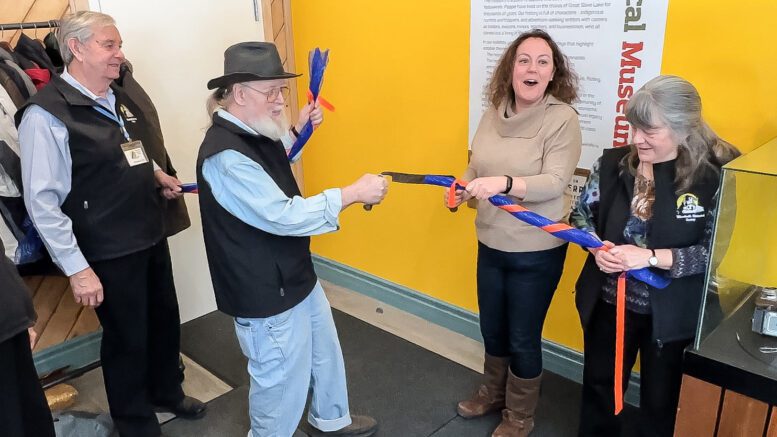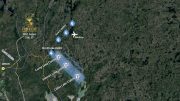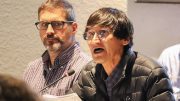The Yellowknife Historical Society made its own bit of history this week, with the grand opening of the Historical Museum & Interpretive Centre.
The Historical Society sought Indigenous and Métis input throughout the development of the museum, as there exists a contentious relationship between Yellowknives Dene First Nation (YKDFN) and the federal government over historic arsenic contamination, and ongoing social, environmental, and economic harm.
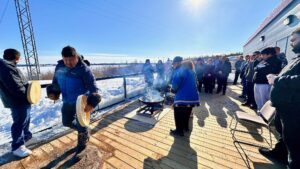
As the approximately 50 funders (including three levels of government), Historical Society members and supporters and local media looked on, Elder Peter Sangris performed a feeding the fire ceremony on the large back deck of the completely renovated 1950’s-era Giant Mine recreation hall, which is on the shores of Back Bay and beside the Yellowknife Sailing Club. Bobby Drygeese, a YK Dene Drummer, at left, helped the Elder complete the ritual.
Former Yellowknives Dene First Nation (YKDFN) Councillor Bobby Drygreese was one of the drummers offering prayers at the start of the opening ceremonies.
Drygeese shared his the invited audience prior to the public opening: “Myself, I got hurt when I was a kid from arsenic and it hurt bad. So, I don’t want nobody else getting hurt. So, we’re going to make sure the (mine remediation) is done the right way. And to make sure that all the all the people that are coming and going are safe.
“For us, we are Yellowknives Dene but we are also Dene. We live here, we’re raised here, we’re born here. Our families are going to be here … we have to make sure that we will help in taking care of taking care of the land … making sure that everything is done the right way.
“People come and go, but we’ve been here for thousands of years, so we have to make sure we help as much as possible and feeding the fire to start this museum is a good start.”
The long rows of ball caps pinned to ceiling beams spanning the gift shop and were also a crowd favourite. The crests on the caps telling their own story of how the mine, city and region developed over time.
Before the ribbon was cut, NWT MP Michael McLeod recalled how a Métis kid from Fort Providence viewed the developments in and around Yellowknife.
 “Museums and heritage places are a part of a vital part of communities spaces. It provides an opportunity to share the community history and the regional history It’s so important to have that for ourselves, but also for the visitors and for the tourists to come to.
“Museums and heritage places are a part of a vital part of communities spaces. It provides an opportunity to share the community history and the regional history It’s so important to have that for ourselves, but also for the visitors and for the tourists to come to.
“It’s amazing how much history I have with the mines here in Yellowknife. Two of my brothers worked for Giant Mine and started their careers here. I remember my brother Eddy was a pitcher for the Giant Grizzlies.
“My own history with mining? I was a pinsetter at Con Mine – I was at Akaitcho Hall, so that’s how I made my spending money.”
McLeod noted the feds have contributed over $1.2 million to the project, and is one partner among many of the community.
The main exhibition hall is surprisingly large, and it is filled with antique large and small, photographs, small rooms staged as a mine office or blacksmith’s shop.
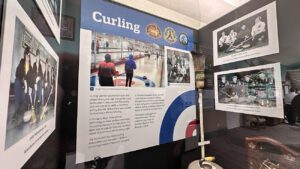 The items on display range from as old as the planet itself, with the main focus on the last half of the 20th century.
The items on display range from as old as the planet itself, with the main focus on the last half of the 20th century.
There are larger-than-life iron wrenches, to forges from blacksmith shops, vintage mining gear and safety equipment, to commonly used everyday items from the 1940s and 1950s that are now curiousities.
Asked about the valuation of some of the pieces, Historical Society directors will say: from sentimental to priceless. How is something valued unless similar items have been on the open market?
Humphries said an example of how long it has taken to realize the museum opening can be told in terms of technology. At the end of the last millennium, discarded typewriters could be found everywhere as computers took over offices.
Now, typewriters are considered chic vintage items found in antique stores.
 Some of the display cases housing Yellowknife’s love of sports, especially curling, were sourced from the Prince of Wales Northern Heritage Centre. Others were adapted from earlier exhibits, such as the large multi-sided case which prominently showcases examples all types of metals – right up to gold, of course.
Some of the display cases housing Yellowknife’s love of sports, especially curling, were sourced from the Prince of Wales Northern Heritage Centre. Others were adapted from earlier exhibits, such as the large multi-sided case which prominently showcases examples all types of metals – right up to gold, of course.
Speaking of the Prince of Wales Centre – operated by the Culture and Heritage Division of the NWT’s Department of Education, Culture and Employment – the YK Historical Society directors spoken to by CKLB say their Historical Museum & Interpretive Centre is just about Yellowknife.
The much larger Prince of Wales Centre is known as the territorial museum, it is also home to the NWT Archives, and hosts school programs, talks, and various other events.
Walt Humphries is a founding member of the Historical Society and is celebrated for his quirky and entertaining watercolours.
 Humphries is originally from Ontario, settled in Yellowknife decades ago and became a prospector, writer and contributor to NNSL Media. His Tales from the Dump weekly column has received national recognition.
Humphries is originally from Ontario, settled in Yellowknife decades ago and became a prospector, writer and contributor to NNSL Media. His Tales from the Dump weekly column has received national recognition.
Humphries has been determined to see the museum project through, and knew Indigenous residents needed to be consulted from the start to make sure their stories were told accurately.
Humphries said Indigenous advisors, “looked at the displays to see if they had any suggestions or comments … is there anything that should be added or deleted.
“Well, with history you deal with facts. The politics of it and the debate that’s a different aspect, but the history is the mine opened at this date, this is how it operated, this how much gold they produced.
“What you think of it, is everybody has a different thought on.”
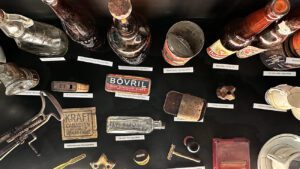 Over two decades in the making, the Historical Society was determined to provide the city with its own facility to preserve and showcase all aspects of community history.
Over two decades in the making, the Historical Society was determined to provide the city with its own facility to preserve and showcase all aspects of community history.
Over $1.5 million was needed to renovate the 1950’s-era Giant Mine recreation hall into the main exhibit hall, which is on the shores of Back Bay and beside the sailing club.
The indoor and outdoor exhibits tell the story of prospecting and industrial mining of gold, local town development and pioneer businesses, regional geology, and the story of early fur trading and Indigenous culture.
Some next steps for the museum include:
- Securing a contractor to run the museum’s café;
- Moving the existing outdoor display closer to the museum itself;
- A much bigger parking lot that can be shared with the Sailing Club; and
- Expanding hours of operation, as the current number of volunteers does not allow for Sunday opening.
The museum’s hours are tentatively 10 a.m. to 5 p.m. Monday through Saturday, including this Easter weekend.
It’s thought initial crowds will be a lot of local residents, as a lot of the contents have never been on display before. Tourists are expected to flock to the facility as the summer season begins.


